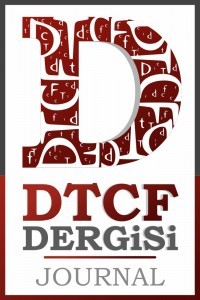THE PARADOX OF FREE WOMEN IN DORIS LESSING'S “THE GOLDEN NOTEBOOK”
Although Doris Lessing's “The Golden Notebook” is regarded as a feminist novel by many scholars, it is also mostly criticised due to the overt male domination upon various female characters. Moving away from the feminist purpose by focusing on the experiences and struggles of these different women characters, Lessing emphasises the significance of peeling off all the socially constructed labels and recognising the distinctive true identity particular to each woman. Following this focus, the author also creates an analogy between the content and the form of the novel by reflecting the chaos in the mind of the women characters to the chaotic form which is divided into parts. Hereby, it can be aptly argued that by building a chaotic atmosphere around the women characters who deem themselves free, Lessing problematises the concept of free women in this particular novel. This paper sets out to analyse how Lessing illustrates the paradox of free women in “The Golden Notebook” through the chaotic content and form.
Anahtar Kelimeler:
Doris Lessing, The Golden Notebook, Free Women, Male Domination, Feminism
THE PARADOX OF FREE WOMEN IN DORIS LESSING'S “THE GOLDEN NOTEBOOK”
Although Doris Lessing's “The Golden Notebook” is regarded as a feminist novel by many scholars, it is also mostly criticised due to the overt male domination upon various female characters. Moving away from the feminist purpose by focusing on the experiences and struggles of these different women characters, Lessing emphasises the significance of peeling off all the socially constructed labels and recognising the distinctive true identity particular to each woman. Following this focus, the author also creates an analogy between the content and the form of the novel by reflecting the chaos in the mind of the women characters to the chaotic form which is divided into parts. Hereby, it can be aptly argued that by building a chaotic atmosphere around the women characters who deem themselves free, Lessing problematises the concept of free women in this particular novel. This paper sets out to analyse how Lessing illustrates the paradox of free women in “The Golden Notebook” through the chaotic content and form.
Keywords:
Doris Lessing, The Golden Notebook, Free Women, Male Domination, Feminism,
___
- Arslan, Seval. “The Mother-Daughter Relationship and the Mother’s Writing Process in Women’s Writing of the 20th and 21st Century.” Diss. İstanbul U, 2016. YOK Archive. Web. 10 Dec. 2018.
- Barnes, Sophia. “‘So Why Write Novels?’ The Golden Notebook, Mikhail Bakhtin, and the Politics of Authorship.” Doris Lessing’s The Golden Notebook After Fifty. Eds. Alice Ridout, Roberta Rubenstein and Sandra Singer. New York: Palgrave Macmillan, 2015. 135-152.
- Cairnie, Julie. “‘Across the Frontiers’: Reading Africa in The Golden Notebook.” Doris Lessing’s The Golden Notebook After Fifty. Eds. Alice Ridout, Roberta Rubenstein and Sandra Singer. New York: Palgrave Macmillan, 2015. 13-32.
- Carey, John L. “Art and Reality in ‘The Golden Notebook.’” Contemporary Literature 14.4 (Autumn 1973): 437-456.JSTOR. Web. 10 Dec. 2018.
- “Doris Lessing’s Golden Notebook, 50 Years On.” The Guardian. N.p. 6 Apr. 2012. Web. 8 Dec. 2018.
- Fuoroli, Caryn. “Doris Lessing’s ‘Game’: Referential Language and Fictional Form.” Twentieth Century Literature 27.2 (Summer 1981): 146-165. JSTOR. Web. 10 Dec. 2018.
- Klein, Carole. Doris Lessing: A Biography. New York: Carroll& Graf P, 2000.
- Lessing, Doris. Preface. The Golden Notebook. New York: Harper Collins, 2008.
- Lessing, Doris. The Golden Notebook. New York: Ballantine, 1962.
- Maslen, Elizabeth. Doris Lessing. Devon: Northcote House P, 2014.
- Moan Rowe, Margaret. Women Novelists: Doris Lessing. London: Macmillan, 1994.
- Mulkeen, Anne M. “Twentieth-Century Realism: The ‘Grid’ Structure of The Golden Notebook.” Studies in the Novel 4.2 (Summer 1972): 262-274. JSTOR. Web. 26 Apr. 2021.
- Ridout, Alice, Roberta Rubenstein and Sandra Singer, eds. Doris Lessing’s The Golden Notebook After Fifty. New York: Palgrave Macmillan, 2015.
- Rubenstein, Roberta. “The Golden Notebook, Disguised Autobiography, and Roman à Clef.” Doris Lessing’s The Golden Notebook After Fifty. Eds. Alice Ridout, Roberta Rubenstein and Sandra Singer. New York: Palgrave Macmillan, 2015. 99-114.
- Schlueter, Paul. “The Golden Notebook.” Bloom’s Modern Classical Views: Doris Lessing. Ed. Harold Bloom. Philadelphia: Chelsea House P, 2003. 27-60.
- Sternberg Perrakis, Phyllis. “Doris Lessing’s The Golden Notebook: Separation and Symbiosis.” American Imago 38.4 (Winter 1981): 407-428. JSTOR. Web. 26 Apr. 2021.
- Whittaker, Ruth. Modern Novelists: Doris Lessing. New York: St. Martins P, 1988.
- Wilson, Elizabeth. “Yesterday’s Heroines: On Rereading Lessing and de Beauvoir.” Notebooks/memoirs/archives: Reading and Rereading Doris Lessing. Ed. Jenny Taylor. London: Routledge, 1982. 57-73. Google Books. Web. 8 Dec. 2018.
- Yayın Aralığı: Yılda 2 Sayı
- Başlangıç: 1942
- Yayıncı: Ankara Üniversitesi
Sayıdaki Diğer Makaleler
TÜRKİYE'DE RÜZGÂR HIZI VERİLERİNİN HOMOJENLEŞTİRİLMESİ VE EĞİLİMLERİ
THE PARADOX OF FREE WOMEN IN DORIS LESSING'S “THE GOLDEN NOTEBOOK”
Zeynep TEK, Tülin ARSLAN, Emine ZEYTUNLU
ROBOTLARIN YÜKSELİŞİ: IAN MCEWAN'IN “BENİM GİBİ MAKİNELER” ROMANINDA ETİK SORUNLARIN İNCELENMESİ
ALASDAIR GRAY'İN “THE FALL OF KELVIN WALKER” ADLI ROMANINDA MEKÂN TEMSİLLERİ
